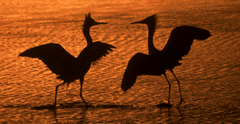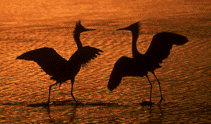Arthur Morris / Birds as Art
Bulletins and Notes Archive
Click any image to enlarge it
|
Bulletins and Notes Archive
|
BIRDS AS ART ON-LINE BULLETIN #49 June 5, 2001
-
"So You Wanna Be a Warbler Photographer..."
-
A note from NANPA's Jerry Bowman

{When you are trying to photograph migrant warblers, you'd
best keep your eyes open for backup subjects... Mourning Dove
feeding young. Magee Marsh. Canon EF 500mm f/4.0 L IS lens,
EOS 1v body, 550 EX Speedlight, Better Beamer flash extender.
Provia F 100 pushed two stops. Flash as fill at -2/3 (automatic
flash reduction canceled). Program mode: 1/250 at f/5.0. }
So You Wanna be a
Warbler Photographer...
The male Bay-breasted Warbler sat totally still for more than
a minute, an eternity for a warbler. He would have filled
three-quarters of the frame, had a wall of leaves not blocked
him. Finally he began feeding, gleaning insects from the
leaves and branches. I pre-focused on the branch that he was
working and followed along attempting to keep his roughly
focused image in the viewfinder. He paused on a clean perch
so I placed the central AF sensor on his face and depressed
the shutter button to achieve sharp focus. Ah, the perfect
image! But alas, though he sat still for several seconds, he
never turned his head towards me, gazing instead at a tiny bug
on the next branch. A flit of his tiny wings and he was gone,
and so was my perfect image.
Carry your tripod-mounted 500 or 600mm lens around for 8 or
more hours until you can barely lift it, repeat the story
above (with variations) a dozen or more times, and you have a
typical day of warbler photography--actually, a good day. On
a bad day, you may not see a single warbler anywhere, even 80
feet up in their typical treetop habitat. Simply put,
photographing migrant warblers and other small songbirds is a
great challenge. It is physically demanding and frustrating.
Since Elaine’s death in 1994, I have visited at least one
spring migrant hotspot each year and have amassed a fine
collection of photographs of northbound migrant passerines. I
am especially proud of these images because unlike many
similar warbler images that you see in magazines, my images
depict free and wild birds. Though I rarely would do so, I
have no problems with those who photograph warblers at the
nest (several species nest on or near the ground), but many
prominent nature photographers work with captive, restrained
songbirds, often birds that have been illegally mist-netted
and photographed in enclosures.
I am often asked, “How do you get all those great warbler
images?” The answer? I try to put myself in the right place
at the right time and then I work very, very hard. As the
folks on my recent IPTs learned, getting a sharply focused
warbler anywhere in the frame with any background at all is a
major accomplishment. Over the years, I have come to realize
that if you are routinely able to produce technically perfect
images on a consistent basis, it takes 7-10 days afield on
average to produce one truly superb image of a small migrant
songbird…
In May of 2001, I spent 16 days in Ohio and Michigan from the
11 th to the 27 th. I spent roughly 8 or
more hours in the field each day, rain or shine. I carried
(only) the 500 mm IS lens (and was glad that I did). I taught
for 9 straight days at Crane Creek/Magee Marsh. The first IPT
group had a very few decent chances with birds down low, most
notably a few of the aforementioned Bay-breasted Warblers. On
the final afternoon, a Yellow-throated Vireo sat for us for
six full minutes on a vine about four feet above eye level.
Most of us exposed two or more rolls of this amazingly
cooperative little bird.

{Yellow-throated Vireo. Magee Marsh. Canon EF 500mm f/4.0
L IS lens, EF TC 2XII, EOS 1v body, 550 EX Speedlight, Better
Beamer flash extender. Provia F 100 pushed two stops. Flash
as main light (automatic fill flash reduction
canceled). Manual Mode: 1/60 sec. at f/8 = 1 1/3 stops under
on the ambient exposure.}
On Wednesday afternoon, my second IPT group had many good
opportunities with warblers feeding at eye level and close
range, but because of the advanced state of the greenery,
flash as main light was the rule; we were basically working
in the dark. The third group saw virtually no
photographable migrant warblers, though some participants
did manage a few nice frames of Yellow Warbler (which breeds
locally). Local weather conditions, with easterly winds
predominating simply were not conducive to producing a
bottleneck of migrants on the south shoe of Lake Erie. (It
was disconcerting to hear that on Thursday, when we saw no
birds at all, there was a huge fallout Point Pelee with
hundreds of birds littering the beaches and bushes at the
tip…)
In addition to weather that was no good for migration, all
of my groups got to experience some simply lousy weather
that included heavy rain. But all three groups did have
many excellent chances with backup subjects at Crane
Creek/Magee Marsh. These included: spectacular Baltimore
Orioles which we attracted with halved oranges; an American
Woodcock incubating chicks; a singing House Wren at his nest
hole; many Canada Geese with goslings (photographed from our
vehicles in the rain); a Whippoorwill sleeping on a log; and
a Killdeer brooding chicks (also from the car).
Photographically speaking, Tree Swallows often saved the
day. We had a lovely natural cavity nest along the
boardwalk. We got to photograph both the male and the female
entering and editing the nest hole, and many participants
got to make images of them copulating. Along the edge of
the marsh, several males that were courting a single female
perched repeatedly on a variety of natural perches at point
blank range.
After I bid farewell to my last group, I flew back to Flint,
Michigan and was picked up by David Vore, a client-friend
who had invited me to photograph spring migration at Tawas
Point State Park along the west shore of Lake Huron (while
using his summer “cottage” as a base. The cottage was
actually a large, beautiful vacation house.) On our first
visit to Tawas Point, we saw lots of birds, especially
Bobolinks, Orchard Orioles, Scarlet Tanagers, and
Rose-Breasted Grosbeaks. And, there were lots of Warbling
Vireos. It was, however, so windy that photography was just
about impossible.
On our second day it was not quite as windy, but there were
fewer birds. We did have some excellent chances with Cedar
Waxwings feeding at close range in a variety of trees. And
then, it started to rain. And it got cold. And the wind
blew, hard from the east--for days. During the last four
days, photography was just about impossible. Tawas does
seem to offer great potential for bird photography, as it is
more open then either Pelee or Magee Marsh. And there are
very few people. Next year I will be leading a single ITP
at Magee Marsh and another at Pelee before heading up to
Taos for a week. Details will follow.
In spite of my really bad luck in 2001, I doubt that I will
ever stop pursuing those tiny bits of fluff and color that
are so difficult to photograph. Oh, I almost forgot, when
we met David’s friend Gary, a local birder, his first words
to us were, “You shoulda been here on Friday!” So you wanna
be a warbler photographer? Here’s a clue: it isn't easy!
Note
from NANPA's Executive Director Jerry Bowman
Jerry e-mailed:
I thought you might like to be aware of the fact that Ellen
Ruldolph's e mail to me and others about the "NANPA Regional
meeting" in France did occur but was not officially approved
by NANPA.. In the words of one of the attendees her e mail
was in fun and in jest I just didn't want your readers or
NANPA members in general have expectations based on her
report.
I replied:
Yes, I realized that the meeting Ellen wrote about was not
officially sanctioned by NANPA (and I assumed that most
folks would understand that her "report" was at least
partly in jest. I will let my Bulletin subscribers know
that the meeting was not officially sanctioned by NANPA to
make absolutely sure that there were no misunderstanding.
On the other hand, I feel that many of the suggestions for
improving NANPA had great merit and ought to be seriously
considered...
Best as always, and respectfully,
Arthur Morris
|
]
[
About Arthur
|
|
]
[ Photo-Tours
|
Books |
Photo Prints
]
[ Bulletin Archive
| FAQ
]
[
Accessories
|
Links ]
|


